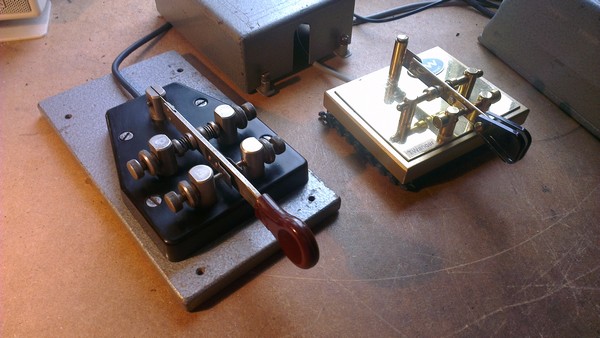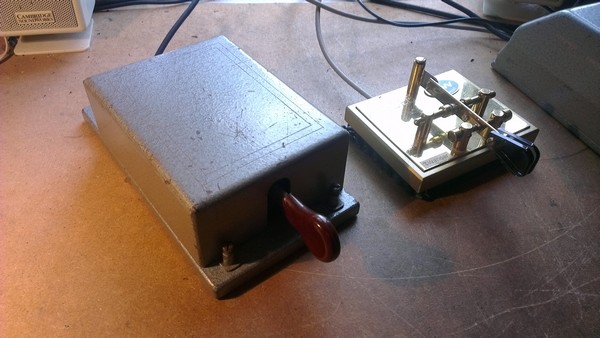PA3DEB's keys.
Kees van der Werf, PA3DEB, Silent Key.
It is with great sadness that we announce that:
Our good friend Kees van der Werf, PA3DEB, has become a Silent Key.
Kees van der Werf, PA3DEB, passed away at age 68 on April 7, 2019.
Obituary notice by his old friend Durk, PA3BYW:
I first met Kees in the early 80's on 3553 kHz which was a hangout for CW-men in the Netherlands and in Belgium then.
Kees has Always been CW fan, ever since he was licensed. We became friends and I frequently visited his house in Feanwâlden.
As Frisians we often made a CW QSO in Frysk which is very unusual.
We lose a dear friend.
Hij had nog zoveel plannen. Het mocht niet zo zijn.
( He still had so many plans. It wasn't allowed to be) R.I.P.)
Kees will be greatly missed.
Our deepest sympathy to Kees van der Werf's family and friends.
Introduction.
My name is Kees, and I was born in 1951. In 1983 I was granted my first licence for VHF/UHF, but my goal was to work CW on the HF bands. Back in those days you had to do a CW-exam to obtain a full licence. You had to be able to send and receive text for 5 minutes at a speed of 12 words per minute. The exam was in December 1983 and January 1984 I got my licence and was assigned c/s PA3DEB.
From that moment on it has been nothing but CW. Don't know why, but I just love doing it.
Started out with a Junker, a few months later came the elbug (first one: Kenpro KP100 Squeeze key), and later someone was kind enough to give me a Hi Mound BK100, sort of a Japanese semi-automatic key. Took me a while to master and try to keep up with the pro's using the real thing: a Vibroplex. Finally got myself an Anniversary Original, about two years ago.
After several years of radio-silence I took up the hobby again a few years ago and soon picked up the pace. Never cared much for computer-Morse, PSK or RTTY and the likes. On our regular hangout 3575 kHz (SRS) one of the guys mentioned he had ordered a TWanger and had a Begali HST for sale. That guy was Miles PA3CVV.
Homebrew Sideswiper #1.
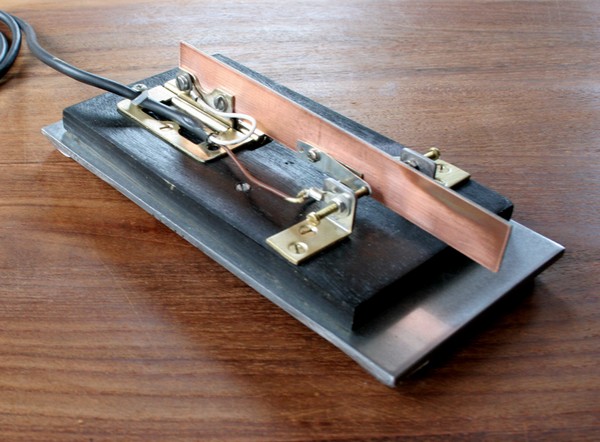 I knew what a sideswiper was, but never looked into them. So that had to change, I did lots of research on the Internet (can't do without the internet nowadays!) and decided to wire my Kent Dual Paddle as a cootie. It seemed to work ok, but it just wasn't the real thing. So that's when the idea arose to build one myself, resulting in an ugly thing producing acceptable code, so I'm told by the ones that had to listen to it...
I knew what a sideswiper was, but never looked into them. So that had to change, I did lots of research on the Internet (can't do without the internet nowadays!) and decided to wire my Kent Dual Paddle as a cootie. It seemed to work ok, but it just wasn't the real thing. So that's when the idea arose to build one myself, resulting in an ugly thing producing acceptable code, so I'm told by the ones that had to listen to it...
In the mean time I modified the Ugly somewhat. The hacksaw-blade was removed and replaced by a strip of PCB. The contacts were taken from an old relay and mounted back to back on the PCB. Like the design of the KDM and/or TWanger. The whole contraption was than mounted on a chunk of steel, which was kindly cut to my specs by a technician from my work. This gives me excellent tactile feedback and a really nice music on the air, I hope!
[PA3DEB].
Homebrew Sideswiper #2.
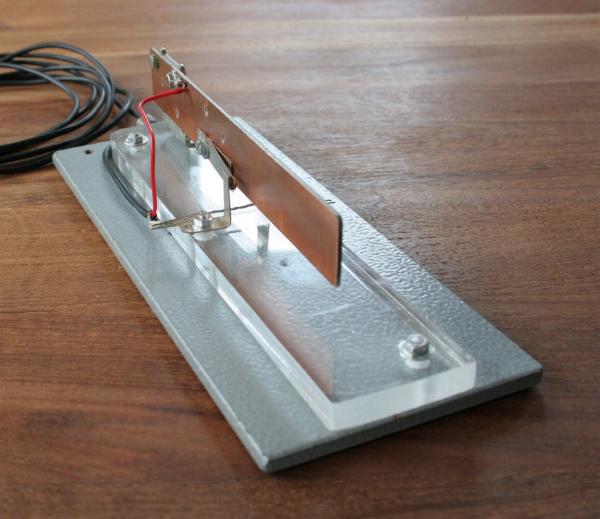 This key was an idea, formed through the inspiration of looking at all different cooties on this website and on peoples own sites. I had some parts left over from building nr 1 and decided to make another one. The motto here has to be: "Simplicity is the key!" And those that have heard it on the air already assured me it sounds good. It was build on a base of Plexiglas with junkbox-parts and relay-contacts. The base is from an old Junker handkey. I don't like Junker keys, so nothing kept me from taking it's baseplate off and mount a real key onto it! Now only if the CONDX would be so good as to improve dramatically so I can have long rag chew QSO's with our USA-friends!
[PA3DEB].
This key was an idea, formed through the inspiration of looking at all different cooties on this website and on peoples own sites. I had some parts left over from building nr 1 and decided to make another one. The motto here has to be: "Simplicity is the key!" And those that have heard it on the air already assured me it sounds good. It was build on a base of Plexiglas with junkbox-parts and relay-contacts. The base is from an old Junker handkey. I don't like Junker keys, so nothing kept me from taking it's baseplate off and mount a real key onto it! Now only if the CONDX would be so good as to improve dramatically so I can have long rag chew QSO's with our USA-friends!
[PA3DEB].
TWanger Sideswiper by TW Radio.
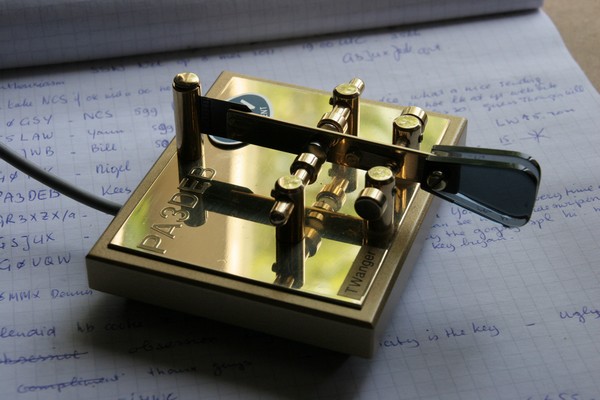 This is the ultimate keying device! Finally I discovered how they do it, producing this lovely CW-music, this really swinging code with a beautiful round tone. It is a delicate and at the same time nearly a surgical instrument, designed by a genius who knows how to cut through QRM while keeping the tone a friendly one.
[PA3DEB].
This is the ultimate keying device! Finally I discovered how they do it, producing this lovely CW-music, this really swinging code with a beautiful round tone. It is a delicate and at the same time nearly a surgical instrument, designed by a genius who knows how to cut through QRM while keeping the tone a friendly one.
[PA3DEB].
USSR KDM Sideswiper.
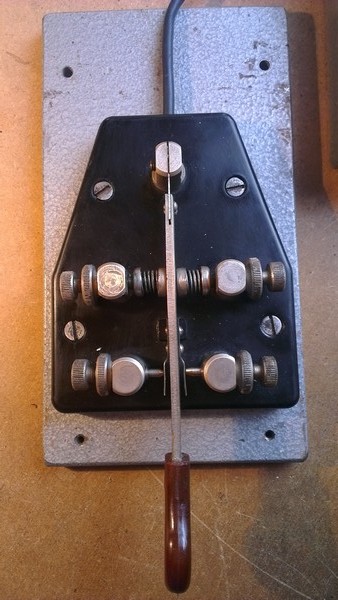 After watching Pete W5PEH's video on the KDM, I fell in love with this very special key and decided to get me one. To that effect I have placed several ads, asking for any offers. In almost a year nobody has come forward with a great deal in mind.
After watching Pete W5PEH's video on the KDM, I fell in love with this very special key and decided to get me one. To that effect I have placed several ads, asking for any offers. In almost a year nobody has come forward with a great deal in mind.
So I was very pleased to read Valery's email, coming via the indispensable and ever-present F5LAW, in which Lery offered one of his KDM's for sale. We soon reached an agreement and the key arrived a few weeks later.
Sadly enough the knob had broken off during transportation. The knobs material looks like a kind of bakelite and there were a lot of loose pieces in the parcel. One of the benefits of the space-age is superglue, which I put to good use, piecing it all together again. The overall effect is: if you don't know it, you don't see it. In these kind of situations, my grandfather used to say: "A blind farmer would gladly give yo a tenner if he could see it!"
But anyway, Valery told me these keys were made during the 1960's at The Test Factory "ЛМНИИП ММФ СССР". Mainly they were units of the shipboard radio set "Ёрш"
(for English ruff) and others. They were very popular among radio officers and at The Soviet Polar Stations.
So far I haven't been able to discover any more information about them, but I keep on looking and researching. Anyone who has a bit more knowledge about the KDM or the KDM-2 is kindly invited to drop me a line through the reflector or via the contact form.
The action is very light and precise and I have found the key is a real racer! But sideswiper-keying is supposed to be fun and not stressful, so I keep it at 25 wpm. Only on rare occasions when I meet Sandy, I'll give it a try at higher speeds. [PA3DEB].
